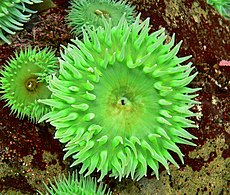混合營養生物:修订间差异
外观
删除的内容 添加的内容
JimGrassroot(留言 | 贡献) |
JimGrassroot(留言 | 贡献) |
||
| 第27行: | 第27行: | ||
* 造礁[[珊瑚]]([[石珊瑚目]])與其他許多[[刺胞動物門]](如水母、海葵)一樣,在細胞內寄生內共生微藻,因此成為混合營養動物。 |
* 造礁[[珊瑚]]([[石珊瑚目]])與其他許多[[刺胞動物門]](如水母、海葵)一樣,在細胞內寄生內共生微藻,因此成為混合營養動物。 |
||
* [[东方胡蜂]](Vespa orientalis)可從其表皮吸收的陽光中獲取能量。<ref name="Plotkin">{{cite journal|author=Plotkin, Hod, Zaban|year=2010|title=Solar energy harvesting in the epicuticle of the oriental hornet (Vespa orientalis) |journal=Naturwissenschaften |volume=97 |pages=1067–1076 |doi=10.1007/s00114-010-0728-1 |pmid=21052618 |issue=12|display-authors=etal|bibcode=2010NW.....97.1067P|s2cid=14022197 }}</ref> 因此,與此處列出的其他動物形成對比,這些動物在內共生體的幫助下屬於混合營養動物。 |
* [[东方胡蜂]](Vespa orientalis)可從其表皮吸收的陽光中獲取能量。<ref name="Plotkin">{{cite journal|author=Plotkin, Hod, Zaban|year=2010|title=Solar energy harvesting in the epicuticle of the oriental hornet (Vespa orientalis) |journal=Naturwissenschaften |volume=97 |pages=1067–1076 |doi=10.1007/s00114-010-0728-1 |pmid=21052618 |issue=12|display-authors=etal|bibcode=2010NW.....97.1067P|s2cid=14022197 }}</ref> 因此,與此處列出的其他動物形成對比,這些動物在內共生體的幫助下屬於混合營養動物。 |
||
<gallery mode="packed" heights="130px"> |
|||
Zooxanthellae.jpg|[[蟲黃藻]]是一種光合藻類,生活在[[珊瑚]]等宿主體內。 |
|||
Anthopleura xanthogrammica 1.jpg|[[黄海葵]] ''Anthopleura xantogrammica'' 從動物小球藻Zoolorella中獲得綠色。 |
|||
Mastigias papua.webmhd.webm|The [[spotted jelly]], a mixotrophic jellyfish, lives in trophic mutualism with [[zooxanthella]], a unicellular organism capable of photosynthesis.<ref>{{cite journal |doi = 10.1007/s00227-019-3581-6|title = Review of the diversity, traits, and ecology of zooxanthellate jellyfishes|year = 2019|last1 = Djeghri|first1 = Nicolas|last2 = Pondaven|first2 = Philippe|last3 = Stibor|first3 = Herwig|last4 = Dawson|first4 = Michael N.|journal = Marine Biology|volume = 166|issue = 11| page=147 | bibcode=2019MarBi.166..147D | s2cid=208553146 |url = https://archimer.ifremer.fr/doc/00604/71661/70246.pdf}}</ref> |
|||
</gallery> |
|||
== 相關條目 == |
== 相關條目 == |
||
2024年9月7日 (六) 19:11的版本
混合營養生物 (英語:Mixotroph),是指在從完全自養的到完全異養的連續體上,混合使用不同的能量和碳源的生物,而非具有單一的營養模式。據估計,混合營養生物佔所有微小浮游生物的一半以上。[1]真核生物混合營養生物有兩種類型。有些擁有自己的葉綠體 - 包括內共生體提供的葉綠體。有些則是透過盜食質體(kleptoplasty)或與獵物的共生關係,或透過 「奴役 」獵物的細胞器而獲得它們。[2]
可能的組合有光能與化能、石能(Lithotroph)與器能(滲透營養、吞噬營養與Myzocytosis)、自能與異能或其他組合。混合營養生物可以是真核生物或原核生物。[3]它們可以利用不同的環境條件。[4]
如果某種營養模式是必須的,那麼它永遠是維持生長和維護的必要條件;如果是兼性的,則可以作為補充的來源。[3]有些生物的卡爾文循環不完整,因此無法固定二氧化碳,必須使用有機碳來源。
概述
生物體可以專性的或兼性的採用混合營養。
- 專性的混合營養:為了支持生長和維持,生物體必須同時利用異養和自養方式。
- 專性的自養與兼性的異養:僅自養足以生長與維持,但當自養能量不足時(例如,當光強度較低時),異養可作為補充策略。
- 兼性的自養和專性的異養:異養足以生長和維持,但自養可用於補充,例如,當獵物可用性非常低時。
- 兼性的混合營養:維持和生長可以單獨透過異養或自養方式獲得,並且混合營養僅在必要時使用。[5]
植物

在植物中,混合營養植物經典上適用於肉食性、半寄生性和真菌异养型的物種。然而,混合營養的特性可以擴展到更多的支系,因為研究顯示氮和磷的有機形式,例如 DNA、蛋白質、氨基酸或碳水化合物,也是許多植物物種營養供應的一部分。[6]
動物
與植物和微生物相比,混合營養動物較不常見,但有許多混合營養無脊椎動物的例子,也至少有一個混合營養脊椎動物的例子。
- 斑點鈍口螈 (Ambystoma maculatum) 的細胞內也會寄生微藻。它的胚胎被發現有共生藻類生活在裡面,[7] 這是脊椎動物細胞寄生內共生微生物的唯一已知例子 (除非考慮線粒體)。[8][9]
- 動物小球藻 (Zoolorella) 是歸屬於小球藻属 (Chlorella) 的綠藻屬的一個保留名称。[10]術語「動物小球藻 Zoolorella」(複數「zoochlorellae」)有時用來指在淡水或海洋無脊椎動物或原生動物體內共生的任何綠藻。
- 造礁珊瑚(石珊瑚目)與其他許多刺胞動物門(如水母、海葵)一樣,在細胞內寄生內共生微藻,因此成為混合營養動物。
- 东方胡蜂(Vespa orientalis)可從其表皮吸收的陽光中獲取能量。[11] 因此,與此處列出的其他動物形成對比,這些動物在內共生體的幫助下屬於混合營養動物。
-
黄海葵 Anthopleura xantogrammica 從動物小球藻Zoolorella中獲得綠色。
-
The spotted jelly, a mixotrophic jellyfish, lives in trophic mutualism with zooxanthella, a unicellular organism capable of photosynthesis.[12]
相關條目
參考資料
- ^ Beware the mixotrophs - they can destroy entire ecosystems 'in a matter of hours'
- ^ [S. G. Leles et al, Oceanic protists with different forms of acquired phototrophy display contrasting biogeographies and abundance, Proceedings of the Royal Society B: Biological Sciences (2017).]
- ^ 3.0 3.1 Eiler A. Evidence for the Ubiquity of Mixotrophic Bacteria in the Upper Ocean: Implications and Consequences. Appl Environ Microbiol. December 2006, 72 (12): 7431–7. Bibcode:2006ApEnM..72.7431E. PMC 1694265
 . PMID 17028233. doi:10.1128/AEM.01559-06.
. PMID 17028233. doi:10.1128/AEM.01559-06.
- ^ Katechakis A, Stibor H. The mixotroph Ochromonas tuberculata may invade and suppress specialist phago- and phototroph plankton communities depending on nutrient conditions. Oecologia. July 2006, 148 (4): 692–701. Bibcode:2006Oecol.148..692K. PMID 16568278. S2CID 22837754. doi:10.1007/s00442-006-0413-4.
- ^ Schoonhoven, Erwin. Ecophysiology of Mixotrophs (PDF). Thesis. January 19, 2000.
- ^ Schmidt, Susanne; John A. Raven; Chanyarat Paungfoo-Lonhienne. The mixotrophic nature of photosynthetic plants. Functional Plant Biology. 2013, 40 (5): 425–438. ISSN 1445-4408. PMID 32481119. doi:10.1071/FP13061
 .
.
- ^ Petherick, Anna. A solar salamander. Nature. 2010-07-30: news.2010.384. ISSN 0028-0836. doi:10.1038/news.2010.384 (英语).
- ^ Frazer, Jennifer. Algae Living inside Salamanders Aren't Happy about the Situation. Scientific American Blog Network. May 18, 2018.
- ^ Burns, John A; Zhang, Huanjia; Hill, Elizabeth; Kim, Eunsoo; Kerney, Ryan. Transcriptome analysis illuminates the nature of the intracellular interaction in a vertebrate-algal symbiosis. eLife. 2 May 2017, 6. PMC 5413350
 . PMID 28462779. doi:10.7554/eLife.22054
. PMID 28462779. doi:10.7554/eLife.22054  .
.
- ^ Compère, Pierre. Report of the Committee for Algae: 6. Taxon. November 1999, 48 (1): 135–136. JSTOR 1224630.
- ^ Plotkin, Hod, Zaban; et al. Solar energy harvesting in the epicuticle of the oriental hornet (Vespa orientalis). Naturwissenschaften. 2010, 97 (12): 1067–1076. Bibcode:2010NW.....97.1067P. PMID 21052618. S2CID 14022197. doi:10.1007/s00114-010-0728-1.
- ^ Djeghri, Nicolas; Pondaven, Philippe; Stibor, Herwig; Dawson, Michael N. Review of the diversity, traits, and ecology of zooxanthellate jellyfishes (PDF). Marine Biology. 2019, 166 (11): 147. Bibcode:2019MarBi.166..147D. S2CID 208553146. doi:10.1007/s00227-019-3581-6.
| 这是一篇與生態學相關的小作品。您可以通过编辑或修订扩充其内容。 |



